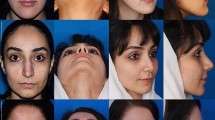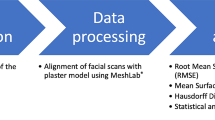Abstract
Objective
Restoration of the philtral region following traumatic, cleft, and tumor surgeries is often difficult due to influence of this feature to whole facial beauty. The aim of this study is to investigate the types and measurements of the philtrum and its relationship with the upper lip using a software.
Methods
Standard personal photographs of the philtral region were obtained from 200 young adults participated in this study. Linear analyses (the lengths of philtral column and dimple; the philtral width) and angular analyses (apex and central angles of Cupid’s bow) were measured as reference points. As for the shape of the philtral column, it was categorized as four distinct types: parallel, triangular, concave, and unclear type.
Results
The philtral width was 11.37 ± 1.9 mm in males, 10.21 ± 1.80 mm in females. The length of the philtral dimple was 18.16 ± 3.6 mm in males, 18.16 ± 3.6 mm in females. Compared with women, both of the measured average philtral reference lengths displayed a significantly greater value in men. In the meanwhile, compared to women, the angular measurements of Cupid’s bow (i.e., the apex and central angle of Cupid’s bow) were smaller in men. It was 127.47 ± 12.74° mm in males, 134.1 ± 11.38° mm in females. The triangular and concave types were associated with a substantial fraction in men, whereas the triangular and parallel types were predominant in women. There were significant gender differences in the esthetic rankings of philtral column shapes.
Conclusions
These results suggest digitalized reference values relative to the philtral column which may increase the success of the individual reconstructive treatment of the surgical procedures and reduce possible asymmetrical appearance. With the help of certain software, this research has made possible to investigate the ideal parameters of philtral construction in defining the best surgical solution for the patient.




Similar content being viewed by others
References
Alley TR, Cunningham MR (1991) Averaged faces are attractive, but very attractive faces are not average. Psychol Sci 2:123–125
Baik HS, Jeon JM, Lee HJ (2007) Facial soft-tissue analysis of Korean adults with normal occlusion using a 3-dimensional laser scanner. Am J Orthod Dentofac Orthop 131:759–766
Bo C, Ningbei Y (2014) Reconstruction of upper lip muscle system by anatomy, magnetic resonance imaging, and serial histological sections. J Craniofac Surg 25(1):48–54
Briedis J, Jackson IT (1981) The anatomy of the philtrum: observations made on dissections in the normal lip. Br J Plast Surg 34(2):128–132
Carey JC, Cohen MM, Curry CJR, Devriendt K, Holmes LB, Verloes A (2009) Elements of morphology: standard terminology for the lips, mouth, and oral region. Am J Med Genet A 149A:77–92
Cho BC (2006) Formation of the philtral column using vertical interdigitation of orbicularis oris muscle flaps in the secondary cleft lip. Plast Resconstr Surg 117:1992–2000
Choi HN, Kim SR, Han YS (2013) A new method for creating a definite philtrum by theflipping of an orbicularis oris muscle flap in a patient with an indistinct philtrum. Arch Plast Surg 40(1):62–65
Farkas LG, Hajnis K, Posnick JC (1993) Anthropometric and anthroposcopic findings of the nasal and facial region in cleft patients before and after primary lip and palate repair. Cleft Palate Craniofac J 30:1–12
Fisher DM (2005) Unilateral cleft lip repair: an anatomical subunit approximation technique. J Plast Reconstr Surg 116(1):61–71
Fukui N, Amano A, Akiyama S, Daikoku H, Wakisaka S, Morisaki I (2000) Oral findings in DiGeorge syndrome. Oral Surg Oral Med Oral Pathol Oral Radiol Endodontol 89:208–215
Garcia de Mitchell CA, Pessa JE, Schaverien MV, Rohrich RJ (2008) The philtrum: anatomical observations from a new perspective. Plast Reconstr Surg 122(6):1756–1760
Germec-Cakan D, Canter HI, Nur B, Arun T (2010) Comparison of facial soft tissue measurements on three-dimensional images and models obtained with different methods. J Craniofac Surg 21:1393–1399
Haramoto U, Kamiji T, Takagi S, Kubo T, Yoshioka N, Hosokawa K (2000) Philtrum construction by composite skin muscle rotation and orbicularis oris muscle advancement in secondary cleft lip deformity. Ann Plast Surg 45:485–490
Hennekam RC, Cormier-Daire V, Hall JG, Méhes K, Patton M, Stevenson RE (2009) Elements of morphology: standard terminology for the nose and philtrum. Am J Med Genet A 194A:61–76
Hood CA, Hosey MT, Bock M, White J, Ray A, Ayoub AF (2004) Facial characterization of infants with cleft lip and palate using a three-dimensional capture technique. Cleft Palate Craniofac J 41:27–35
Jones LR, Tatum SA (2008) Pearls for aesthetic reconstruction of cleft lip and nose defects. Facial Plast Surg 24(1):146–151
Kishi N, Tanaka S, Iida S, Kogo M (2012) The morphological features and developmental changes of the philtral dimple: a guide to surgical intervention in cases of cleft lip. J Craniomaxillofac Surg 40(3):215–222
Kishi N, Tanaka S, Iida S, Kogo M (2011) Comprehensive evaluation of three-dimensional philtral morphology. J Craniofac Surg 22(5):1606–1611
Latham RA, Deaton TG (1976) The structural basis of the philtrum and the contour of the vermilion border: a study of the musculature of the upper lip. J Anat 121:151–160
Mulliken JB, Pensler JM, Kozakewich HP (1993) The anatomy of Cupid’s bow in normal and cleft lip. Plast Reconstr Surg 92(3):395–403 (discussion 404)
Nakajima T, Tamada I, Miyamoto J, Nagasao T, Hikosaka M (2008) Straight line repair of unilateral cleft lip. J Plast Reconstr Aesthet Surg 61:870–878
Nakamura N, Suzuki A, Takahashi H, Honda Y, Sasaguri M, Ohishi M (2005) A Longitudinal study on influence of primary facial deformities on maxillofacial growth in patients with cleft lip and palate. Cleft Palate Craniofac J 42:633–640
Pepper JP, Shan RB (2013) Local flaps: cheek and lip reconstruction. JAMA Facial Plast Surg 15(5):374–382
Peret DI, Lee KJ, Penton-Voak I, Rowland D, Yoshikawa S, Burt DM, Henzi SP, Castles DL, Akamatsu S (1998) Effects of sexual dimorphism on facial attractiveness. Nature 394:884–887
Pinar YA, Bilge O, Govsa F (2005) Anatomic study of the blood supply of perioral region. Clin Anat 18(5):330–339
Raphael P, Harris R, Harris SW (2013) Analysis and classification of the upper lip aesthetic unit. Plast Reconstr Surg 132(3):543–551
Rogers CR, Meara JG, Mulliken JB (2014) The philtrum in cleft lip: review of anatomy and techniques for construction. J Craniofac Surg 25(1):9–138
Tirone L, Moscatiello F, Molea G (2006) Reconstruction of the upper lip and philtrum. J Plast Reconstr Aesthet Surg 59(8):865–866
Zimmerer KS, Chaitidis D, Boerner I, Kovacs L, Schwenzer NF, Holberg C, Zeilhofer HF (2008) Systematic contact-free 3D topometry of the soft tissue profile in cleft lips. Cleft Palate Craniofac J 45:607–613
Zimmerer KS, Chaitidis D, Boerner I, Krol Z, Kovacs L, Schwenzer NF, Zimmerer S, Holberg C, Zeilhofer HF (2008) Quantitative 3D soft issue analysis of symmetry prior to and after unilateral cleft lip repair compared with non-cleft persons (performed in Cambodia). J Craniomaxillofac Surg 36:431–438
Author information
Authors and Affiliations
Corresponding author
Ethics declarations
Conflict of interest
All the authors certify that they have no potential conflicts of interest with any entity mentioned in this manuscript and that they received no specific financial support for this work.
Rights and permissions
About this article
Cite this article
Bagheri, H., Sirinturk, S., Govsa, F. et al. Digitalized analysis of philtral anatomy for planning individual treatment. Surg Radiol Anat 39, 1183–1189 (2017). https://doi.org/10.1007/s00276-017-1840-0
Received:
Accepted:
Published:
Issue Date:
DOI: https://doi.org/10.1007/s00276-017-1840-0




